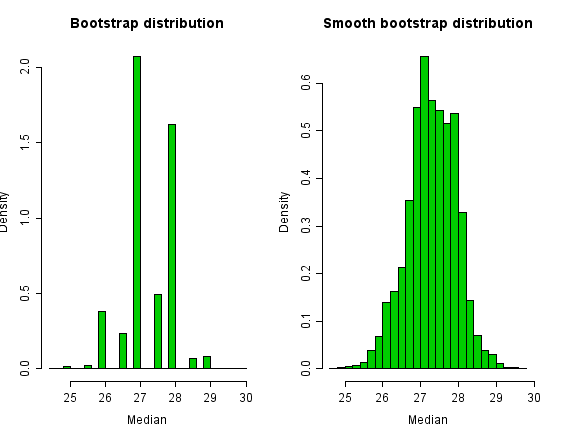Bootstrapping (statistics)
|MedianHists|thumb|left]]|thumb|left]] Bootstrapping (statistics) is a resampling method used in statistics to estimate the distribution of a sample statistic. It involves repeatedly drawing samples, with replacement, from an observed dataset and calculating the statistic of interest for each sample. This method allows for the estimation of the sampling distribution of almost any statistic using random sampling methods. Bootstrapping is a powerful tool because it does not rely on the assumption of normality and can be applied in situations where the theoretical distribution of the statistic is unknown or difficult to derive.
Overview[edit | edit source]
Bootstrapping was introduced by Bradley Efron in 1979 and has since become a fundamental technique in statistical inference. The basic idea is to create a "bootstrap" sample by randomly selecting observations from the original dataset with replacement. This process is repeated a large number of times (typically thousands or more), and for each bootstrap sample, the desired statistic is computed. The collection of these statistics forms an empirical distribution, which can then be used to estimate properties such as the mean, variance, confidence intervals, and hypothesis testing.
Procedure[edit | edit source]
The general procedure for bootstrapping involves several steps:
- From the original dataset of size n, draw a sample of size n with replacement. This sample is known as a bootstrap sample.
- Calculate the statistic of interest for the bootstrap sample.
- Repeat steps 1 and 2 a large number of times (e.g., 1000 or 10000 times) to create a distribution of the bootstrap statistics.
- Use the distribution of bootstrap statistics to estimate the desired characteristics of the sampling distribution of the statistic (e.g., its variance, bias, confidence intervals).
Types of Bootstrapping[edit | edit source]
There are several types of bootstrapping methods, including but not limited to:
- Non-parametric bootstrapping: The most straightforward form, which does not assume any specific parametric form for the data distribution.
- Parametric bootstrapping: Assumes that the data follow a certain distribution and samples are drawn from that distribution instead of the original dataset.
- Block bootstrapping: Used for data that are correlated over time, such as time series data, where blocks of data are resampled instead of individual observations.
Applications[edit | edit source]
Bootstrapping is used in various statistical applications, including:
- Estimating the distribution of a sample mean or median
- Constructing confidence intervals for a population parameter
- Hypothesis testing
- Model selection and validation in machine learning
Advantages and Limitations[edit | edit source]
Advantages:
- Does not require the assumption of normality or other specific distributional assumptions.
- Can be applied to complex estimators or those with no closed-form distribution.
- Useful in situations with small sample sizes.
Limitations:
- Bootstrap methods can be computationally intensive, especially with large datasets and a high number of resampling iterations.
- Not always appropriate for data with strong dependencies, such as time series, without modifications (e.g., block bootstrapping).
- The accuracy of bootstrap confidence intervals can depend on the choice of the method (e.g., percentile method, BCa method).
Conclusion[edit | edit source]
Bootstrapping is a versatile and powerful statistical tool that has broad applications in statistical inference. Its ability to estimate the distribution of a statistic without relying on strict assumptions about the population from which the sample is drawn makes it invaluable in practical statistical analysis and research.
This article is a statistics-related stub. You can help WikiMD by expanding it!
Search WikiMD
Ad.Tired of being Overweight? Try W8MD's physician weight loss program.
Semaglutide (Ozempic / Wegovy and Tirzepatide (Mounjaro / Zepbound) available.
Advertise on WikiMD
|
WikiMD's Wellness Encyclopedia |
| Let Food Be Thy Medicine Medicine Thy Food - Hippocrates |
Translate this page: - East Asian
中文,
日本,
한국어,
South Asian
हिन्दी,
தமிழ்,
తెలుగు,
Urdu,
ಕನ್ನಡ,
Southeast Asian
Indonesian,
Vietnamese,
Thai,
မြန်မာဘာသာ,
বাংলা
European
español,
Deutsch,
français,
Greek,
português do Brasil,
polski,
română,
русский,
Nederlands,
norsk,
svenska,
suomi,
Italian
Middle Eastern & African
عربى,
Turkish,
Persian,
Hebrew,
Afrikaans,
isiZulu,
Kiswahili,
Other
Bulgarian,
Hungarian,
Czech,
Swedish,
മലയാളം,
मराठी,
ਪੰਜਾਬੀ,
ગુજરાતી,
Portuguese,
Ukrainian
Medical Disclaimer: WikiMD is not a substitute for professional medical advice. The information on WikiMD is provided as an information resource only, may be incorrect, outdated or misleading, and is not to be used or relied on for any diagnostic or treatment purposes. Please consult your health care provider before making any healthcare decisions or for guidance about a specific medical condition. WikiMD expressly disclaims responsibility, and shall have no liability, for any damages, loss, injury, or liability whatsoever suffered as a result of your reliance on the information contained in this site. By visiting this site you agree to the foregoing terms and conditions, which may from time to time be changed or supplemented by WikiMD. If you do not agree to the foregoing terms and conditions, you should not enter or use this site. See full disclaimer.
Credits:Most images are courtesy of Wikimedia commons, and templates, categories Wikipedia, licensed under CC BY SA or similar.
Contributors: Prab R. Tumpati, MD



